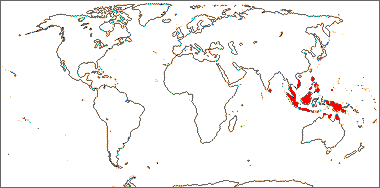Family name: Hanguanaceae Airy Shaw
Synonym(s): [none]
Common name(s): hanguana family
*Number of genera/species: 1/12
List of genera records in GRIN-Global
fruit
Fruit a berryberry:
an indehiscent, fleshy fruit with one or a few to many seeds. The flesh may be homogenous throughout. Or, if the outer part is hard, firm, or leathery, referred to as an hesperidium. Septa are present in some, and the seeds may be arillate or with a fleshy testa. , 1–20 mm long, globoseglobose:
, 1–20 mm long, globoseglobose:
3D shape—more or less spherical to ovoidovoid:
to ovoidovoid:
3D shape—ovate , with one to three seeds, often hardened stigmastigma:
, with one to three seeds, often hardened stigmastigma:
the portion of the pistil receptive to pollen persistent. Pericarppericarp:
persistent. Pericarppericarp:
fruit wall or fruit coat
black, purple, red, yellow, or white, often speckled, shinyshiny:
uniformly reflecting a high proportion of incident light at all angles , thick, fleshy.
, thick, fleshy.
Seeds hemisphericalhemispherical:
2D shape—shaped like half a sphere
, sometimes globoseglobose:
3D shape—more or less spherical , tereteterete:
, tereteterete:
approximately circular in cross section; width and thickness approximately equal
 in transection, 3–6 mm long. Seed coat thick, sclerifiedsclerified:
in transection, 3–6 mm long. Seed coat thick, sclerifiedsclerified:
texture—hardened
, appearing dulldull:
reflecting only a low proportion of incident light, with no apparent sheen with a reticulatereticulate:
with a reticulatereticulate:
surface relief—netted, raised walls or concave grooves forming a net-like surface pattern with flat, concave, or convex interspaces , striatestriate:
, striatestriate:
surface relief—having fine, parallel lines, grooves or ridges , or pittedpitted:
, or pittedpitted:
surface relief—surface with small depressions in which the areas between the hollows do not take on the appearance of a true reticular net surface.
surface.
Embryo rudimentaryrudimentary:
(of embryo) embryo is small and fills less than a quarter of the seed and can be variable in shapes, such as linear, spatulate, or oval , globoseglobose:
, globoseglobose:
3D shape—more or less spherical , straight.
, straight.
Endosperm copious.
| Fruit | |
| Type | berryberry: an indehiscent, fleshy fruit with one or a few to many seeds. The flesh may be homogenous throughout. Or, if the outer part is hard, firm, or leathery, referred to as an hesperidium. Septa are present in some, and the seeds may be arillate or with a fleshy testa.  |
| Size range | 1–20 mm long |
| Shape(s) | ellipsoidellipsoid: 3D shape—elliptic , globoseglobose: 3D shape—more or less spherical  , ovoidovoid: , ovoidovoid:3D shape—ovate  |
| Texture | fleshy |
| Color(s) | white, red, black, yellow, white, purple |
| Unique features | Small, fleshy, often speckled berriesberry: an indehiscent, fleshy fruit with one or a few to many seeds. The flesh may be homogenous throughout. Or, if the outer part is hard, firm, or leathery, referred to as an hesperidium. Septa are present in some, and the seeds may be arillate or with a fleshy testa.  with hardened persistent stigmasstigma: with hardened persistent stigmasstigma:the portion of the pistil receptive to pollen  . . |
| Seed | |
| Size range | 3–6 mm long |
| Shape(s) | globoseglobose: 3D shape—more or less spherical  , hemisphericalhemispherical: , hemisphericalhemispherical:2D shape—shaped like half a sphere |
| Surface relief | reticulatereticulate: surface relief—netted, raised walls or concave grooves forming a net-like surface pattern with flat, concave, or convex interspaces  , striatestriate: , striatestriate:surface relief—having fine, parallel lines, grooves or ridges  , pittedpitted: , pittedpitted:surface relief—surface with small depressions in which the areas between the hollows do not take on the appearance of a true reticular net  |
| Unique features | Seeds deeply bowl shaped (hemisphericalhemispherical: 2D shape—shaped like half a sphere ) with thick, sclerifiedsclerified: texture—hardened , sculptured seed coats. |
| Other | |
| Embryo | rudimentaryrudimentary: (of embryo) embryo is small and fills less than a quarter of the seed and can be variable in shapes, such as linear, spatulate, or oval  , globoseglobose: , globoseglobose:3D shape—more or less spherical  , straight , straight |
| Nutritive tissue | endosperm copious |
Sri Lanka, Southeast Asia to Northern Australia.

Distribution map courtesy of Angiosperm Phylogeny Website.
Baskin and Baskin 2021Baskin and Baskin 2021:
Baskin C and Baskin J. 2021. Relationship of the lateral embryo (in grasses) to other monocot embryos: A status up-grade. Seed Science Research 31 (3): 199-210. doi:10.1017/S0960258521000209; Dahlgren et al. 1985Dahlgren et al. 1985:
Dahlgren RMT, Clifford HT, and Yeo PF. 1985. The families of the monocotyledons: structure, evolution, and taxonomy. Springer-Verlag, Berlin. 520 pp.; Kirkbride et al. 2006Kirkbride et al. 2006:
Kirkbride JH, Jr, Gunn CR, and Dallwitz MJ. 2006. Family guide for fruits and seeds, vers. 1.0. Accessed September 2020-January 2022. URL: https://nt.ars-grin.gov/seedsfruits/keys/frsdfam/index.cfm .; Kubitzki et al. 1990+Kubitzki et al. 1990+:
Kubitzki K et al., eds. 1990+. The families and genera of vascular plants. 7+ vols. Berlin etc.; Leong-Škorničková and Niissalo 2017; Siti Nurfazilah et al. 2010Siti Nurfazilah et al. 2010:
Siti Nurfazilah AR, Ahmad Sofiman O, Mohd Fahmi AB, and Boyce PC. 2010. Studies on Hanguana (Commelinales, Hanguanaceae) for Sunda II: Five new forest species from Peninsular Malaysia and recircumscription of Hanguana malayana . Willdenowia 40 (2): 205-219. https://doi.org/10.3372/wi.40.40206; Stevenson and Loconte 1995Stevenson and Loconte 1995:
Stevenson DW and Loconte H. 1995. A cladistic analysis of monocot families. In: Rudall PJ, Cribb PJ, Cutler DF, and Humphries CJ, eds. Monocotyledons: Systematics and Evolution. Royal Botanic Gardens, Kew.
*The number of genera and species is based on Christenhusz and Byng 2016Christenhusz and Byng 2016:
Christenhusz MJM and Byng JW. 2016. The number of known plant species in the world and its annual increase. Phytotaxa 261 (3): 201-217. https://doi.org/10.11646/phytotaxa.261.3.1, which may differ from the number of genera in GRIN-Global.